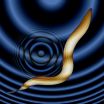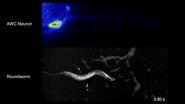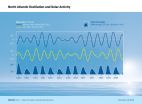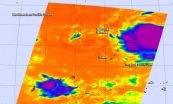(Press-News.org) LA JOLLA--Salk scientists have developed a new way to selectively activate brain, heart, muscle and other cells using ultrasonic waves. The new technique, dubbed sonogenetics, has some similarities to the burgeoning use of light to activate cells in order to better understand the brain.
This new method--which uses the same type of waves used in medical sonograms--may have advantages over the light-based approach--known as optogenetics--particularly when it comes to adapting the technology to human therapeutics. It was described September 15, 2015 in the journal Nature Communications.
"Light-based techniques are great for some uses and I think we're going to continue to see developments on that front," says Sreekanth Chalasani, an assistant professor in Salk's Molecular Neurobiology Laboratory and senior author of the study. "But this is a new, additional tool to manipulate neurons and other cells in the body."
In optogenetics, researchers add light-sensitive channel proteins to neurons they wish to study. By shining a focused laser on the cells, they can selectively open these channels, either activating or silencing the target neurons. But using an optogenetics approach on cells deep in the brain is difficult: typically, researchers have to perform surgery to implant a fiber optic cable that can reach the cells. Plus, light is scattered by the brain and by other tissues in the body.
Chalasani and his group decided to see if they could develop an approach that instead relied on ultrasound waves for the activation. "In contrast to light, low-frequency ultrasound can travel through the body without any scattering," he says. "This could be a big advantage when you want to stimulate a region deep in the brain without affecting other regions," adds Stuart Ibsen, a postdoctoral fellow in the Chalasani lab and first author of the new work.
Chalasani and his colleagues first showed that, in the nematode Caenorhabditis elegans, microbubbles of gas outside of the worm were necessary to amplify the low-intensity ultrasound waves. "The microbubbles grow and shrink in tune with the ultrasound pressure waves," Ibsen says. "These oscillations can then propagate noninvasively into the worm."
Next, they found a membrane ion channel, TRP-4, which can respond to these waves. When mechanical deformations from the ultrasound hitting gas bubbles propagate into the worm, they cause TRP-4 channels to open up and activate the cell. Armed with that knowledge, the team tried adding the TRP-4 channel to neurons that don't normally have it. With this approach, they successfully activated neurons that don't usually react to ultrasound.
So far, sonogenetics has only been applied to C. elegans neurons. But TRP-4 could be added to any calcium-sensitive cell type in any organism including humans, Chalasani says. Then, microbubbles could be injected into the bloodstream, and distributed throughout the body--an approach already used in some human imaging techniques. Ultrasound could then noninvasively reach any tissue of interest, including the brain, be amplified by the microbubbles, and activate the cells of interest through TRP-4. And many cells in the human body, he points out, can respond to the influxes of calcium caused by TRP-4.
"The real prize will be to see whether this could work in a mammalian brain," Chalasani says. His group has already begun testing the approach in mice. "When we make the leap into therapies for humans, I think we have a better shot with noninvasive sonogenetics approaches than with optogenetics."
Both optogenetics and sonogenetics approaches, he adds, hold promise in basic research by letting scientists study the effect of cell activation. And they also may be useful in therapeutics through the activation of cells affected by disease. However, for either technique to be used in humans, researchers first need to develop safe ways to deliver the light or ultrasound-sensitive channels to target cells.
INFORMATION:
Other researchers on the study were Stuart Ibsen and Ada Tong of the Salk Institute, and Carolyn Schutt and Sadik Esener of the University of California, San Diego.
The work and the researchers involved were supported by a Salk Institute Pioneer Fund Postdoctoral Fellowship, a Salk Institute Innovation Grant, the Rita Allen Foundation, the W.M. Keck Foundation and the National Institutes of Health.
About the Salk Institute for Biological Studies:
The Salk Institute for Biological Studies is one of the world's preeminent basic research institutions, where internationally renowned faculty probes fundamental life science questions in a unique, collaborative and creative environment. Focused both on discovery and on mentoring future generations of researchers, Salk scientists make groundbreaking contributions to our understanding of cancer, aging, Alzheimer's, diabetes and infectious diseases by studying neuroscience, genetics, cell and plant biology and related disciplines.
Faculty achievements have been recognized with numerous honors, including Nobel Prizes and memberships in the National Academy of Sciences. Founded in 1960 by polio vaccine pioneer Jonas Salk, MD, the Institute is an independent nonprofit organization and architectural landmark.
The addition of a daily outdoor activity class at school for three years for children in Guangzhou, China, resulted in a reduction in the rate of myopia (nearsightedness, the ability to see close objects more clearly than distant objects), according to a study in the September 15 issue of JAMA.
Myopia has reached epidemic levels in young adults in some urban areas of East and Southeast Asia. In these areas, 80 percent to 90 percent of high school graduates now have myopia. Myopia also appears to be increasing, more slowly, in populations of European and Middle Eastern ...
Women are less likely than men to be full professors at U.S. medical schools, and receive less start-up support from their institutions for biomedical research, according to two studies in the September 15 issue of JAMA.
Women now make up half of all U.S. medical school graduates. However, sex disparities in senior faculty rank persist in academic medicine. Whether differences in age, experience, specialty, and research productivity between sexes explain persistent disparities in faculty rank has not been studied. Anupam B. Jena, M.D., Ph.D., of Harvard Medical School, ...
Patients undergoing surgery for a hip fracture were older and had more medical conditions than patients who underwent an elective total hip replacement, factors that may contribute to the higher risk of in-hospital death and major postoperative complications experienced by hip fracture surgery patients, according to a study in the September 15 issue of JAMA.
Although hip surgery can improve mobility and pain, it can be associated with major postoperative medical complications and mortality. Patients undergoing surgery for a hip fracture are at substantially higher risk ...
Women physicians are substantially less likely to be full professors than men of similar age, experience, specialty and research productivity.
With recent increases in the number of women attending medical school, women now comprise nearly half of all new physicians. But the proportion of women at the rank of fullprofessor at U.S. medical schools has not changed since 1980, despite efforts to increase equity, according to a new research study led by Anupam Jena, associate professor of health care policy at Harvard Medical School. The results are published today in JAMA.
"Many ...
A group of scientists from ITMO University, Australian National University and Aalto University called into question the results of a study, published by the researchers from Cambridge University in a prestigious scientific journal Physical Review Letters. In the original study, the British scientists claimed that they managed to find the missing link in the electromagnetic theory. The findings, according to the scientists, could help decrease the size of antennas in electronic devices manifold, promising a major breakthrough in the field of wireless communications.
The ...
Drugs commonly used to treat high blood pressure, and prevent heart attacks and strokes, are associated with significantly worse cardiovascular outcomes in hypertensive African Americans compared to whites, according to a new comparative effectiveness research study led by researchers in the Department of Population Health at NYU Langone Medical Center.
The study, published on September 15 in the Journal of the American College of Cardiology (JACC), is unique, the authors say, in that it evaluates racial differences in cardiovascular outcomes and mortality between hypertensive ...
Are climate predictions over periods of several years reliable if weather forecast are still only possible for short periods of several days? Nevertheless there are options to predict the development of key parameters on such long time scales. A new study led by scientists at GEOMAR Helmholtz Centre for Ocean Research Kiel shows how the well-known 11-year cycle of solar activity affects the long-time development of dominant large-scale pressure systems in the Northern Hemisphere.
For their investigations the scientists used a coupled ocean-atmosphere model. In addition, ...
September 15, 2015 - Nyon, Switzerland A study from the University of Southampton and Sheffield Medical School in the UK projects a dramatic increase in the burden of fragility fractures within the next three decades. By 2040, approximately 319 million people will be at high risk of fracture -double the numbers considered at high risk today.
In this first study to estimate the global burden of disease in terms of fracture probability, the researchers quantified the number of individuals worldwide aged 50 years or more at high risk of fracture in 2010 and projected figures ...
Marijuana use among American high school students is significantly lower today than it was 15 years ago, despite the legalization in many states of marijuana for medical purposes, a move toward decriminalization of the drug and the approval of its recreational use in a handful of places, new research suggests.
The Johns Hopkins Bloomberg School of Public Health researchers say, however, that marijuana use is significantly greater than the use of other illegal drugs, with 40 percent of teens in 2013 saying they had ever smoked marijuana. That number was down from 47 percent ...
The twentieth tropical depression of the Northwestern Pacific Ocean formed early on September 14 and became a tropical storm the next day, triggering a tropical storm watch. NASA's Aqua satellite passed over the low pressure area as it was consolidating and saw powerful thunderstorms circling the center.
The Atmospheric Infrared Sounder or AIRS instrument that flies aboard NASA's Aqua satellite gathers data in infrared light that provides information about temperatures. The colder the cloud top temperature, the higher the storms are in the troposphere (because the higher ...



